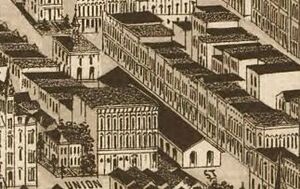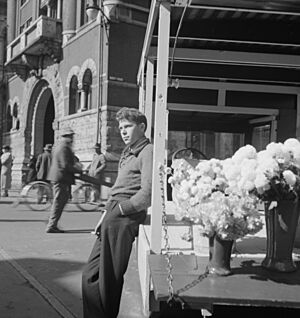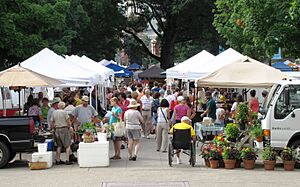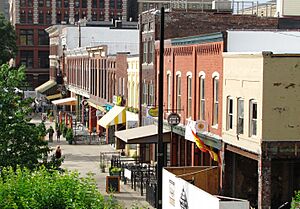Market Square, Knoxville facts for kids
Quick facts for kids |
|
|
Market Square Commercial Historic District
|
|

Market Square, viewed from the north end
|
|
| Location | Market Sq. Mall, Knoxville, Tennessee |
|---|---|
| Area | approximately 13 acres (5.3 ha) |
| Built | circa 1870–1925 |
| Architect | multiple |
| Architectural style | Classical Revival, Italianate, Vernacular Commercial |
| NRHP reference No. | 84001138 |
| Added to NRHP | December 20, 1984 |
Market Square is a lively outdoor area in Knoxville, Tennessee. It's a special place where people can walk around and enjoy different activities. It started way back in 1854 as a place for farmers to sell their fresh food.
Over the years, Market Square has become a popular spot for many things. You can find concerts, political speeches, and even artists and musicians performing. It's a place where people from all walks of life gather. From 1868 to 1924, Knoxville's City Hall was also located here. In 1984, Market Square was recognized as a historic place and added to the National Register of Historic Places.
The land for Market Square was given to the city by William G. Swan and Joseph A. Mabry. Farmers would bring their wagons to the Market House to sell their goods. During the American Civil War, the Market House was even used by the Union Army as a place for soldiers to stay and store supplies.
After the Civil War, Knoxville grew a lot, and Market Square grew too. Famous buildings like Peter Kern's candy store (now The Oliver Hotel) opened in 1876. Max Arnstein's big seven-story department store opened in 1906. Sadly, the Market House was damaged by fire in 1960 and later torn down. After that, Market Square was turned into the pedestrian area we see today.
One local newspaper called Market Square "the most democratic place on earth." This meant that everyone, no matter their background, could meet and mix freely there. Many famous writers, like James Agee and Cormac McCarthy, have mentioned Market Square in their books. Musicians from Duke Ellington to Steve Winwood have performed here. Important people like Booker T. Washington and Ronald Reagan have also given speeches in the Square.
Contents
Exploring Market Square's Location
Market Square is right in the middle of downtown Knoxville. It's an open space that covers a bit more than one acre. Shops and businesses line the east and west sides of the Square.
Union Avenue is to the south, and Wall Avenue is to the north. There are also narrow alleys behind the shops that connect to Gay Street on the east and Walnut Street on the west. Nearby, you'll find Krutch Park and the tall TVA Towers.
Market Square is one of the few places in Knoxville where street addresses still use an old numbering system. This system starts numbering at "1," unlike the newer system used elsewhere in the city, which has longer numbers.
A Look Back at Market Square's History
How Market Square Began
Knoxville's very first market building was built in 1816 on Main Street. But it was sold by 1823. For the next 30 years, farmers just sold their goods from their wagons on the streets.
In 1853, two men, William G. Swan and Joseph A. Mabry, bought a large piece of land. They gave a small part of this land, which is now Market Square, to the city. They wanted a new market house built there. The deal was that the land had to be used for a market, or it would go back to them or their families.
The first Market House was designed by Newman & Maxwell and opened in January 1854. At first, not many farmers used it because they preferred selling from their wagons. But soon, shops started to appear around the Square. These included a grocery store, a place to buy drinks, a lumberyard, and even a bowling alley.
By 1861, Market Square was important enough to be a voting place. During the American Civil War in late 1863, the Union Army took over Knoxville. They turned the Market House into a place for soldiers to sleep and store ammunition. Shopkeepers around the Square were worried about all the gunpowder being stored there. For many years after the war, groups of Confederate and Union veterans would meet regularly in buildings on Market Square.
Knoxville's Growth Period
In 1868, Knoxville built its first permanent City Hall at the north end of Market Square. The Market House was made bigger the next year. This left only a small space between it and City Hall.
Around the same time, Peter Kern, a German immigrant and Civil War veteran, opened his "ice cream saloon" on the Square. In 1876, Kern finished the building now known as The Oliver Hotel. The first floor was his candy shop, the second floor was a fancy ice cream parlor, and the third floor was a meeting place.
By 1876, Market Square had many different businesses. These included a hat shop, a doctor, a pharmacy, a dressmaker, and a jewelry store. There were also places that sold drinks. The Knoxville Chronicle newspaper moved its office to Market Square in the 1870s. This is where famous newspaper publisher Adolph Ochs started his career. By the late 1880s, the City Hall building was too small, so a larger one was finished in 1888.
Sausage maker Adolph Ziegler started selling sausages from the Ziegler Building in the 1880s. Two other companies, Baum's and H. T. Hackney, also began as shops on Market Square during this time. In 1897, the city built an even larger Market House. It had an auditorium on the second floor and was connected to City Hall. Market Square was at its busiest in 1906 when Max Arnstein built his seven-story department store. It was the tallest building in Knoxville at the time.
Changes and Comeback
In 1907, a city rule stopped the sale of alcohol, and Market Square's places that sold drinks had to close. As new neighborhoods grew outside downtown, people started to move away. In 1925, Peter Kern's business was sold, and his building became a drugstore. That same year, Knoxville's City Hall moved to a new location. In 1927, Max Arnstein retired, and his department store closed.
Even with these changes, new businesses kept coming to the Square. A local grocery chain, the White Stores, opened a store in 1927. Regional grocer Cas Walker opened one of his stores in the early 1940s. Movie theaters also started to appear, like the Rialto in the late 1920s and the Crystal in the 1930s. During this time, John Demetrius Cavalaris opened the Golden Sun, a business that stayed on the Square for many years.
In the 1950s, Knoxville's mayor, George Dempster, wanted to tear down the Market House. He thought it would help make downtown better. Even though people like poet Carl Sandburg tried to save the building, the city voted to remove it in November 1959. The building was also partly burned a few months later.
The old Market House was replaced in 1961 by the Market Square Mall. This was an open-air market with white, mushroom-shaped canopies. The mall got a boost when the TVA Towers were finished in 1976 and Krutch Park was built in 1981. In 1986, people who wanted to protect old buildings asked for the white canopies to be removed. The Market Square Mall was then renamed "Market Square."
Market Square's Culture and Fun
Musicians have been a part of Market Square since the late 1860s. Peter Kern even hired brass bands for his parties. In the 1880s, "Dr. Lighthall's Mexican Band" played on the Square. Tennessee politician and fiddler Robert Love Taylor also performed with the "Market Hall Fiddlers."
In the 1920s, fiddle contests were held in Market Hall. These contests attracted famous musicians like Charlie Bowman. By the 1980s, many different types of music, like bluegrass, jazz, folk, and punk, were played in Market Square's clubs. From 1997 to 2011, the Sundown in the City concert series brought huge crowds of over 10,000 people to the Square.
Market Square has also appeared in many books. In his famous novel A Death in the Family, James Agee wrote about visiting a noisy bar in Market Square in 1915. He also mentioned his favorite store on the Square, Harbison's.
Cormac McCarthy describes Market Square vividly in his novels The Orchard Keeper (1965) and Suttree (1979). Both books are set in Knoxville. In The Orchard Keeper, a character sees a street preacher on the Square before buying things at a hardware store. In Suttree, the main character sells his fish to a vendor on Market Square. He passes many interesting people, like "blind singers" and "wild street preachers."
Other books that mention Market Square include The Seas of God by Anne W. Armstrong and Bijou by David Madden. More recently, it appears in An Affair of Honor by Richard Marius and The Highly Effective Detective by Richard Yancey.
Political groups have been active at Market Square since at least 1876. Temperance activists, who wanted to stop the sale of alcohol, were very vocal in the early 1900s. Leaders like William Jennings Bryan and Frances Willard gave speeches at Market Hall. Women's voting rights activist Lizzie Crozier French was active on Market Square in the 1880s. Today, there's a memorial on the Square to honor women's suffrage.
In 1904, socialist politician Harry McKee spoke at the Square. Booker T. Washington gave a speech about civil rights there in 1909. In 1980, Republican presidential candidate Ronald Reagan spoke to 6,000 people at Market Square. Democratic candidate Walter Mondale also spoke there in 1984.
Market Square Today
Today, Market Square is used all year round for special outdoor events. These include the Market Square Farmers' Market, where local farmers sell their produce. There are also annual outdoor Shakespeare plays and concerts by community bands.
The bell from the old market house is on display at the Union Avenue end of Market Square. Nearby, you'll find the Women's Suffrage Memorial. This statue was created by sculptor Alan LeQuire to remember Tennessee's important role in helping women get the right to vote in the United States. Every winter, an ice skating rink is set up in the Square for everyone to enjoy.
Historic Buildings of Market Square
Market Square was listed as the Market Square Commercial Historic District on the National Register of Historic Places in 1984. The buildings around the Square show different styles of architecture from the 1800s and 1900s. Most of them used to have shops on the ground floor and homes on the upper floors.
The historic district includes twenty important buildings. Seventeen of these are right on the Square, and three are on Union or Wall avenues. Some buildings were changed in the mid-1900s but have since been restored to their original look.
Here are some interesting buildings in the district:
- The Oliver Hotel (1 Market Square) is a beautiful building from 1876. It was designed by Joseph Baumann. This building used to be Peter Kern's candy and ice cream shop. Peter Kern was a German immigrant who fought in the Confederate States Army. He became a successful baker and later opened his own shop here. He sold bread, candy, ice cream, and cakes. The upper floor even had a ballroom where people learned to dance. Kern was elected mayor of Knoxville in 1890. In 1982, the top two floors became a hotel called the Blakely House for visitors to the 1982 World's Fair. It later became the Hotel St. Oliver.
- The Ziegler Building (9 Market Square) is a three-story building built around 1880. It has a fancy metal roof edge, decorative columns, and a raised wall at the top. Sausage-maker Adolph Ziegler and his partners sold sausage and pork from this building in the 1880s and 1890s.
- 26 Market Square is a commercial building built around 1880. It was home to the A.L. Young Dry Goods Store from 1880 to 1900. Other dry goods shops were in this building until 1950.
- 36 Market Square was built around 1882. It also housed many dry goods stores from 1885 until the 1960s.
- 37 Market Square, known as the J.F. Horne Building, is a Victorian-style commercial building from around 1870. It housed tobacco and liquor sellers J.F. Horne & Brothers from 1876 to 1905. After that, it became a restaurant and candy shop. The Gold Sun Café was located here from 1920 until at least 1965.
- The Arnstein Building (corner of Union and Market) was finished in 1906. It was designed by Cleverdon & Putzel from New York. At seven stories tall, it was Knoxville's tallest building when it was completed. It has classical details and limestone blocks on its corners. The building housed Max Arnstein's department store until 1927. In the 1930s, it was used as office space for the new Tennessee Valley Authority. Whittle Communications also had offices in the Arnstein Building in the 1980s.
Knoxville Market Square
- Neely, Jack (2009), A History of Knoxville’s Market Square: The Most Democratic Place on Earth, University of Tennessee Press, ISBN: 0-578-00305-8









